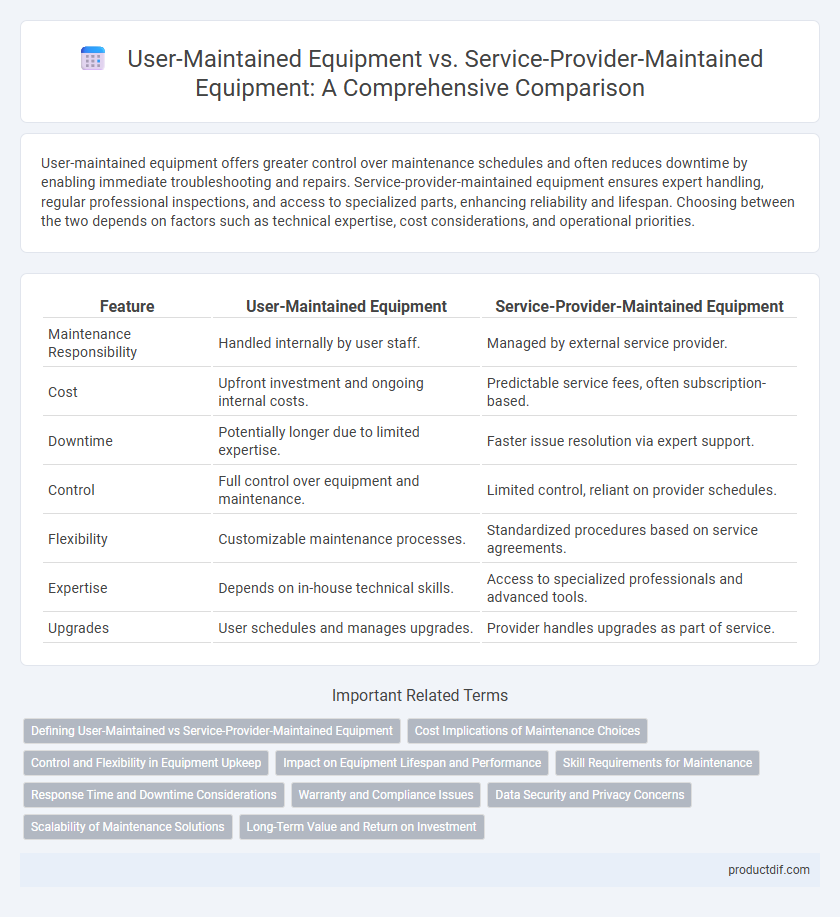User-maintained equipment offers greater control over maintenance schedules and often reduces downtime by enabling immediate troubleshooting and repairs. Service-provider-maintained equipment ensures expert handling, regular professional inspections, and access to specialized parts, enhancing reliability and lifespan. Choosing between the two depends on factors such as technical expertise, cost considerations, and operational priorities.
Table of Comparison
| Feature | User-Maintained Equipment | Service-Provider-Maintained Equipment |
|---|---|---|
| Maintenance Responsibility | Handled internally by user staff. | Managed by external service provider. |
| Cost | Upfront investment and ongoing internal costs. | Predictable service fees, often subscription-based. |
| Downtime | Potentially longer due to limited expertise. | Faster issue resolution via expert support. |
| Control | Full control over equipment and maintenance. | Limited control, reliant on provider schedules. |
| Flexibility | Customizable maintenance processes. | Standardized procedures based on service agreements. |
| Expertise | Depends on in-house technical skills. | Access to specialized professionals and advanced tools. |
| Upgrades | User schedules and manages upgrades. | Provider handles upgrades as part of service. |
Defining User-Maintained vs Service-Provider-Maintained Equipment
User-maintained equipment refers to devices and machinery that the equipment owner is responsible for inspecting, repairing, and ensuring operational functionality without relying on external service contracts. In contrast, service-provider-maintained equipment relies on third-party experts or vendors who conduct regular maintenance, troubleshooting, and repairs under a service agreement or warranty plan. Clearly defining these categories impacts cost management, downtime risk, and the overall maintenance strategy implemented within an organization.
Cost Implications of Maintenance Choices
User-maintained equipment often reduces direct service fees but may increase costs related to parts replacement and downtime due to varying maintenance quality. Service-provider-maintained equipment typically involves higher upfront expenses or service contracts but ensures professional upkeep, potentially extending equipment lifespan and minimizing unplanned repairs. Evaluating the total cost of ownership, including labor, parts, and operational impact, is critical when choosing between user and provider maintenance options.
Control and Flexibility in Equipment Upkeep
User-maintained equipment offers greater control and flexibility, allowing organizations to customize maintenance schedules and quickly address specific issues without relying on external service providers. This autonomy enables tailored upkeep strategies that can extend equipment lifespan and optimize performance according to real-time operational needs. Conversely, service-provider-maintained equipment may limit direct oversight but benefits from specialized expertise and standardized maintenance processes.
Impact on Equipment Lifespan and Performance
User-maintained equipment often experiences inconsistent upkeep, which can lead to reduced equipment lifespan and suboptimal performance due to missed or improper maintenance tasks. Service-provider-maintained equipment benefits from regular, expert inspections and timely repairs, ensuring enhanced durability and optimal operational efficiency. Investing in professional maintenance services significantly mitigates the risks of unexpected breakdowns and performance degradation.
Skill Requirements for Maintenance
User-maintained equipment requires operators to possess basic technical skills and understanding of routine maintenance procedures such as cleaning, lubrication, and inspection to ensure consistent performance. Service-provider-maintained equipment relies on specialized technicians with advanced diagnostic abilities and expertise in complex repairs, calibration, and software updates. Skill requirements for maintenance directly impact equipment downtime, reliability, and overall operational efficiency.
Response Time and Downtime Considerations
User-maintained equipment typically offers faster response times for minor issues since on-site personnel can address problems immediately, reducing overall downtime. Service-provider-maintained equipment often benefits from specialized expertise and scheduled maintenance, which can minimize unplanned failures but may involve longer wait times for repairs. Evaluating the balance between immediate availability of technical support and comprehensive servicing is critical to optimizing equipment uptime and operational efficiency.
Warranty and Compliance Issues
User-maintained equipment often risks voiding manufacturer warranties due to improper handling or unauthorized repairs, leading to increased liability and non-compliance with safety regulations. Service-provider-maintained equipment ensures adherence to warranty terms and compliance standards through certified technicians and documented maintenance processes. This approach minimizes warranty disputes and regulatory penalties, safeguarding operational reliability and legal accountability.
Data Security and Privacy Concerns
User-maintained equipment poses increased data security and privacy risks due to inconsistent updates and lack of professional oversight, potentially leading to vulnerabilities exploitable by cyber threats. Service-provider-maintained equipment benefits from regular security patches, expert management, and compliance with industry standards, reducing the likelihood of data breaches. Organizations must weigh control benefits against security risks when choosing between user-maintained and service-provider-maintained equipment to protect sensitive information effectively.
Scalability of Maintenance Solutions
User-maintained equipment offers flexible scalability by allowing on-site adjustments and immediate responses to minor issues, reducing downtime. Service-provider-maintained equipment ensures scalable expertise through scheduled professional maintenance, supporting complex system updates and minimizing long-term operational risks. Combining both approaches can enhance overall scalability by balancing quick access with specialized technical support for diverse equipment needs.
Long-Term Value and Return on Investment
User-maintained equipment typically offers higher long-term value by reducing ongoing service costs and allowing for tailored maintenance schedules that extend operational lifespan. Service-provider-maintained equipment often ensures consistent performance through expert servicing, minimizing downtime but potentially increasing total cost of ownership over time. Evaluating return on investment requires balancing immediate maintenance expenses against long-term durability and efficiency gains specific to each maintenance approach.
User-maintained equipment vs service-provider-maintained equipment Infographic

 productdif.com
productdif.com